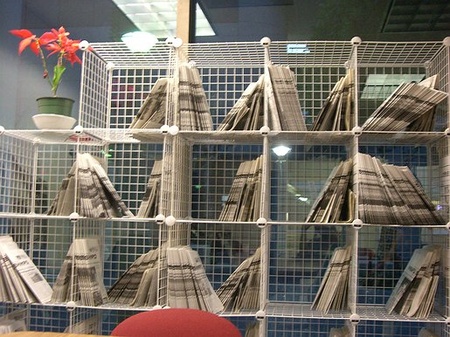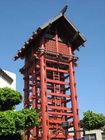Following the events of World War II, Akira Komai, with the help of three other businessmen, helped the Rafu Shimpo newspaper restart on January 1, 1946. After the bank refused to give funding to the project, three of Komai’s friends offered their savings to restore the newspaper to its former glory.
The existence of the Rafu Shimpo after World War II was especially significant for friends and relatives divided by the Japanese internment camps. The newspaper provided valuable information to the Japanese community slowly trickling back into Little Tokyo after WWII. Later, it also began to help businesses recreate themselves after the war by advertising their new location and specialties to the people of Little Tokyo. The paper successfully managed to rebuild itself in the aftermath of World War II through both the determination of Akira Komai and three trusting businessmen, and the needs of the Little Tokyo community.
Since then, the paper has survived over time, adapting to the constantly shifting nature of the world around it. The most difficult moments for the Rafu Shimpo arose from without rather than within.
On April 29, 1992, the Rodney King incident sparked a violent riot in Los Angeles. As the situation escalated, the Rafu Shimpo office stopped printing and sent its employees home. Though the riot had not reached Little Tokyo, the Rafu Shimpo office was close to skid row and people were touchy.
According to Mickey Komai, the current publisher of the newspaper, “At that point, you didn’t know who was going to attack someone else who wasn’t the same color or shape as [they were].”Sending workers home served as a preventative measure, as it was better to be safe than sorry. During that time, very limited information came from the Northern and Western areas affected by the riots. Miraculously enough, the L.A. riots migrated north and spared the newspaper from violence and destruction.
Another poignant time for the Rafu Shimpo spawned from the events of 9/11. After the fall of the Twin Towers, discrimination towards those of Arabic descent increased, and unfair treatment escalated dramatically. Gwen Muranaka, an editor for the Rafu Shimpo, remembers this time as being particularly striking because the Japanese community came together to aid those being persecuted without cause.
The racist attitudes towards people of Arabic descent after the events of 9/11 closely paralleled the Japanese American community’s own experience with the racist attitudes they were unfortunately confronted with after the bombing of Pearl Harbor. Because of the Japanese Americans’ background in unjustified racism, they were able to connect with those outside of their own community who were suffering from the same poor reactions of the system.
Through its stories and its reactions to outside events, the Rafu Shimpo manages to engage the community of Little Tokyo and keep everyone together and informed. Says Komai, “Some people have tried to describe the Rafu as the history of the Japanese American community,” and this statement rings true. From its start-up in 1903, its fall in 1942, its recovery in 1946, and its continuation into present day, the Rafu Shimpo has, in Komai’s words, “…walk[ed] hand in hand, step in step, with the history of Little Tokyo.” By covering news of significance to the local community, the Rafu Shimpo has chronicled the history of Little Tokyo, providing the glue that keeps the people together.
Recently, the Rafu Shimpo has been experiencing economic hardship. But that has not stopped people from supporting the paper or fighting for its continued existence. Komai remarks, “It’s amazing how many people know of the Rafu or know something of the Rafu. And once [we] get too full of [ourselves], it’s amazing how many people don’t.” Although there are those who are unaware of the Rafu Shimpo, those who know the newspaper will stop at nothing to maintain its growth.
During a recent meeting to discuss the future of the Rafu Shimpo, Komai commented on the huge amount of energy in the room and the tremendous support for the paper. In a powerful presentation of goodwill, people offered constructive criticism and friendly suggestions to boost the circulation of the paper. Says Komai, “It’s one thing to say your company has built goodwill; it’s another to see it manifest. I can’t quantify it, can’t put my finger on it. The goodwill in that room was so big you could’ve just scooped it up with a spoon. You could almost touch [it] as something that was solid, something that was material.”
Increasing circulation and bringing in more revenue for the Little Tokyo newspaper requires different methods than other periodicals because the Rafu Shimpo is an “atypical newspaper.” Twenty years ago, the newspaper was carried 60-70% by advertising revenue. Now, unlike most newspapers in circulation, for the Rafu Shimpo, 70% of revenue is subscription-based.
Another means of contributing to their revenue is a family tree project connected with the Japanese American National Museum. Catered to Japanese Americans who are curious about their ancestral background, the project provides a retail shop that works through an agent in Japan to research and uncover an individual’s roots.
Although in the past year, numerous newspapers switched to online-only reporting, Komai prefers having both print and online versions of the Rafu Shimpo, in order to satisfy both older and younger readers.
The paper has survived through subscriptions but falters because of what is called the “pass-along rate”:approximately one newspaper gets “passed along” to four other people. People can show their support for this community paper by buying their own copy, in order to ensure that, in the future, there will continue to be a Rafu Shimpo to keep the community of Little Tokyo informed and connected.
** Discover Nikkei partnered with Professor Morgan Pitelka of Occidental College and his students taking the Spring 2010 seminar “Japanophilia: Orientalism, Nationalism, Transnationalism” on a meaningful community-based documentation project. The students interviewed owners of five long-time Little Tokyo businesses to create Nikkei Albums and articles.
View the Nikkei Album: A Look at the Rafu Shimpo
© 2010 Vedette Philip





